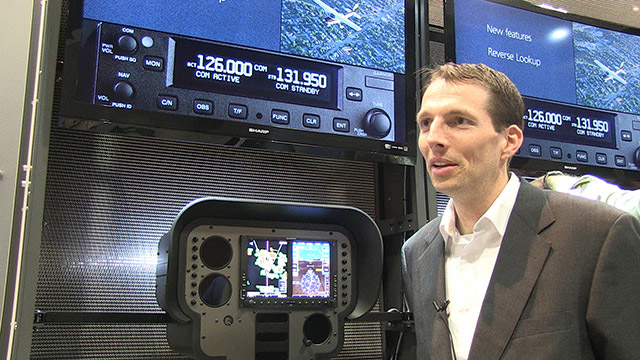
Garmin announced a pair of new active traffic alert systems, and what amounts to an upgrade of an existing system priced at the entry level on March 26 at the Aircraft Electronics Association convention in Las Vegas.
The GTS 825 and GTS 855 are higher-power versions of the GTS 800 approved in 2009. All three offer a hybrid collision avoidance system that draws on incoming Automatic Dependent Surveillance-Broadcast (ADS-B) signals, as well as actively interrogating transponders of nearby aircraft. Priced at $19,995, the GTS 825 is a 40-watt system with a range of 40 nautical miles; the GTS 855 retails for $24,995, and has the same power rating with an 80-nautical-mile range, and meets the FAA Traffic Alert and Collision Avoidance System I (TCAS) standard. Both can be upgraded in the field.
At the more affordable end of the market, owners of the GTS 800 received a free “upgrade,” with additional testing having validated the $9,995 unit’s range from 12 nm to 22 nm.
“It’s actually been exceeding our own specification by a considerable amount,” said Jim Alpiser, Garmin’s director of aviation after-market sales.
Garmin, like other avionics manufacturers, is pitching the active alert system as a valuable complement to ADS-B technology. The GTS systems are able to “see” aircraft equipped with transponders, but not transmitting ADS-B signals.
 Garmin’s GTS 825. Photo courtesy Garmin.
Garmin’s GTS 825. Photo courtesy Garmin.
Speaking of ADS-B, Garmin shipped “hundreds” the GDL-88 ADS-B transceiver following the announcement in January that the unit is approved for installation in most Part 23 fixed-wing aircraft. Priced at $3,995, the GDL-88 is designed to offer a low-cost route to complying with the ADS-B Out mandate set to take effect in 2020, when all aircraft operating in controlled airspace must broadcast an ADS-B position signal (supported by Wide Area Augmentation System GPS).
“From a technological standpoint, I think we’ve really hit the mark,” Alpiser said, noting the GDL-88 broadcasts both the 978 MHz Universal Access Transceiver and 1090 MHz frequencies. The device can capture datalink weather and traffic data for display on a Garmin display, or select third-party displays. “It’s almost like you can’t afford not to install it sooner than later.”
Alpiser and the Garmin staff were also showing off the relatively new GTR and GNC series aviation radios, announced in January. Designed to replace the SL 30 and SL 40 models, GTR 225 is a communications radio (starting at $1,995) with an upgraded display that includes text identifying the tuned frequency. The GNC is a nav/comm version of the same system, with the GNC 225 starting at $4,495 for the 10-watt version. (Both are also available in 16-watt versions.) When connected to a panel-mounted or portable GPS, the radios can look up frequencies for nearby facilities. Airport and navaid identifiers can also be input to display a list of available frequencies. The GTR series is upgradable to the 8.33 kHz channel separation mandate for operations in Europe, a standard feature on the GNC series.
All of the new radios include a standby monitor allowing the pilot to listen to ATIS without leaving the ATC frequency.
Garmin also announced new products for helicopters, including a GTN 650/750 approval for helicopter operations, and the GRA 5500 radar altimeter. Garmin was also talking up a new line of products designed for the experimental and light sport markets.
“We stay busy, that is for sure,” Alpiser said.
 Jim Alpiser, Garmin’s director of aviation after-market sales, talks up new product offerings at the Aircraft Electronics Association convention in Las Vegas.
Jim Alpiser, Garmin’s director of aviation after-market sales, talks up new product offerings at the Aircraft Electronics Association convention in Las Vegas.



